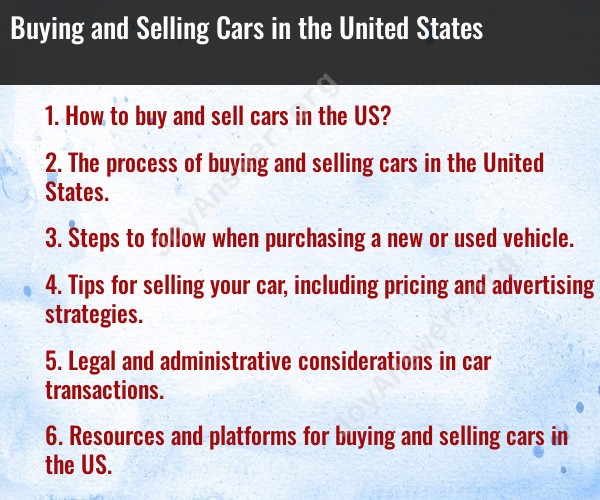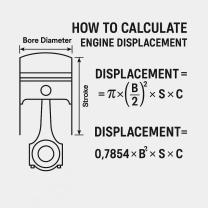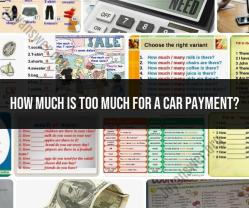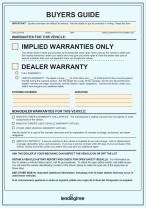How to buy and sell cars in the US?
Buying and selling cars in the United States involves several steps and considerations to ensure a smooth and legal transaction. Here's a general guide for both buying and selling cars in the US:
Buying a Car:
Determine Your Budget: Decide how much you're willing to spend on a car, taking into account not only the purchase price but also ongoing costs like insurance, maintenance, and fuel.
Research and Choose a Vehicle: Research the type of car you want, considering factors like brand, model, age, mileage, and features. You can use online resources, visit dealerships, or explore private listings to find the right car.
Inspect the Car: If you find a car you're interested in, inspect it thoroughly. It's a good idea to have a trusted mechanic or an inspection service check the vehicle's condition.
Obtain a Vehicle History Report: Request a vehicle history report, which can provide information about the car's past, including accidents, title issues, and maintenance records.
Negotiate the Price: Negotiate the price with the seller. Be prepared to haggle and reach an agreement that both parties are comfortable with.
Secure Financing (if needed): If you're not paying for the car in cash, you may need to secure financing through a bank or credit union. Shop around for the best loan terms and interest rates.
Complete a Bill of Sale: When you and the seller agree on the terms, create a bill of sale that includes the vehicle details, the sale price, and the names and signatures of both parties. Some states may require specific forms for this purpose.
Obtain a Title Transfer: To transfer ownership of the car, you need the title. Ensure the seller provides a clean and signed title, and complete the necessary paperwork to transfer it into your name.
Register and Insure the Car: Register the car with your state's Department of Motor Vehicles (DMV) and obtain insurance before driving the vehicle. Requirements for registration and insurance can vary by state.
Selling a Car:
Prepare the Car: Clean the car thoroughly, make necessary repairs, and gather all relevant documents, including the title, service records, and any warranty information.
Set the Price: Research the market to determine a fair selling price for your vehicle. Consider factors like age, mileage, condition, and current market trends.
Create a Listing: You can advertise your car through various methods, such as online listings (e.g., Craigslist, AutoTrader, or local classifieds), social media, or by placing a "For Sale" sign in the car's window.
Screen Potential Buyers: When potential buyers inquire about your car, ask them questions to ensure they are serious and financially capable of making the purchase.
Arrange Test Drives and Inspections: Allow interested buyers to inspect and test drive the car. Be prepared to answer their questions and provide maintenance records.
Negotiate the Price: Be open to negotiations but also have a minimum acceptable price in mind.
Complete the Sale: When you and the buyer agree on the terms, create a bill of sale and complete the necessary paperwork for the title transfer.
Release Liability: Contact your state's DMV to inform them of the sale and release your liability for the vehicle. This is important to prevent any future issues related to the car.
Remove Your License Plates: Remove your license plates from the vehicle and return them to the DMV, as they are typically associated with the seller, not the car itself.
Hand Over the Keys: Once the payment and paperwork are complete, provide the buyer with the keys, title, and any other relevant documents.
It's essential to be aware of your state's specific regulations and requirements for buying and selling cars, as they can vary. Always use caution and ensure the transaction is safe and legal. If you're uncertain about any aspect of the process, consider seeking guidance from your state's DMV or consult with a legal professional.
The process of buying and selling cars in the United States
Buying a car
- Do your research. Before you start shopping for a car, it's important to do your research and understand the different types of cars available, as well as their features, prices, and fuel efficiency. You can use online resources, such as Edmunds or Kelley Blue Book, to compare different car models and find the best deals.
- Get pre-approved for a loan. This will give you an idea of how much you can afford to spend on a car and make the shopping process easier. You can get pre-approved for a loan from a bank, credit union, or online lender.
- Shop around. Once you've done your research and gotten pre-approved for a loan, it's time to start shopping for a car. You can visit car dealerships, private sellers, or online car marketplaces. Be sure to test drive different cars before you make a decision.
- Negotiate the price. Once you've found a car that you want to buy, it's time to negotiate the price. Don't be afraid to haggle with the seller to get the best deal possible.
- Finalize the sale. Once you've agreed on a price, it's time to finalize the sale. This will involve signing paperwork and paying for the car.
Selling a car
- Prepare your car for sale. This includes cleaning the car inside and out, making any necessary repairs, and getting a car wash. You may also want to have the car professionally detailed.
- Set a price. It's important to set a competitive price for your car. You can use online resources, such as Kelley Blue Book, to get an estimate of the value of your car.
- Advertise your car. You can advertise your car online, through classified ads, or by putting a sign in the window. Be sure to include photos and a detailed description of your car.
- Show your car to potential buyers. Be prepared to answer questions about your car and to take potential buyers for test drives.
- Negotiate the price. Be prepared to negotiate the price of your car with potential buyers.
- Finalize the sale. Once you've agreed on a price with a buyer, it's time to finalize the sale. This will involve signing paperwork and transferring the title of the car to the buyer.
Legal and administrative considerations in car transactions
There are a number of legal and administrative considerations to keep in mind when buying or selling a car. These include:
- Title transfer: When you buy a car, you will need to transfer the title of the car from the seller to your name. This can be done at your local Department of Motor Vehicles (DMV).
- Registration: Once you have transferred the title of the car, you will need to register the car with your local DMV. This process will involve paying registration fees and obtaining license plates.
- Insurance: You are required by law to have car insurance in the United States. You can purchase car insurance from a variety of insurance companies.
Resources and platforms for buying and selling cars in the US
There are a number of resources and platforms available for buying and selling cars in the United States. These include:
- Online car marketplaces: Online car marketplaces, such as Carvana and Vroom, allow you to buy and sell cars entirely online.
- Car dealerships: Car dealerships sell new and used cars. They can also help you finance your purchase.
- Private sellers: You can also buy and sell cars from private sellers. You can find private sellers online or through classified ads.
It's important to do your research and compare different resources and platforms before you buy or sell a car. You should also be aware of the legal and administrative considerations involved in car transactions.













